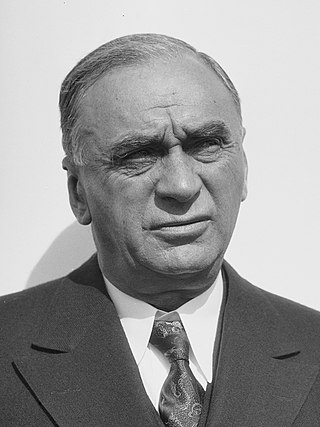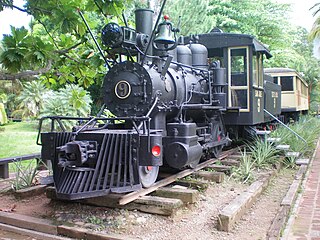
Honduras was inhabited by many indigenous peoples when the Spanish arrived in the 16th century. The western-central part of Honduras was inhabited by the Lencas, the central north coast by the Tol, the area east and west of Trujillo by the Pech, the Maya and Sumo. These autonomous groups maintained commercial relationships with each other and with other populations as distant as Panama and Mexico. Honduras has ruins of several cities dating from the Mesoamerican pre-classic period that show the pre-Columbian past of the country.

The United Fruit Company was an American multinational corporation that traded in tropical fruit grown on Latin American plantations and sold in the United States and Europe. The company was formed in 1899 from the merger of the Boston Fruit Company with Minor C. Keith's banana-trading enterprises. It flourished in the early and mid-20th century, and it came to control vast territories and transportation networks in Central America, the Caribbean coast of Colombia and the West Indies. Although it competed with the Standard Fruit Company for dominance in the international banana trade, it maintained a virtual monopoly in certain regions, some of which came to be called banana republics – such as Costa Rica, Honduras, and Guatemala.

Puerto Cortés, originally known as Puerto de Caballos, is a port city and municipality on the north Caribbean coast of Honduras, right on the Laguna de Alvarado, north of San Pedro Sula and east of Omoa, with a natural bay. The present city was founded in the early colonial period. It grew rapidly in the twentieth century, thanks to the then railroad, and banana production. In terms of volume of traffic the seaport is the largest in Central America and the 36th largest in the world. The city of Puerto Cortés has a population of 73,150.

Chiquita Brands International S.à.r.l., formerly known as Chiquita Brands International Inc. and United Fruit Co., is a Swiss-domiciled American producer and distributor of bananas and other produce. The company operates under a number of subsidiary brand names, including the flagship Chiquita brand and Fresh Express salads. Chiquita is the leading distributor of bananas in the United States.

Samuel Zemurray, nicknamed "Sam the Banana Man", was an American businessman who made his fortune in the banana trade. He founded the Cuyamel Fruit Company and later became president of the United Fruit Company, the world's most influential fruit company at the time. Both companies played highly controversial roles in the history of several Latin American countries and had a significant influence on their economic and political development.

Standard Fruit Company was established in the United States in 1924 by the Vaccaro brothers. Its forerunner was started in 1899, when Sicilian Arberesh immigrants Joseph, Luca and Felix Vaccaro, together with Salvador D'Antoni, began importing bananas to New Orleans from La Ceiba, Honduras. By 1915, the business had grown so large that it bought most of the ice factories in New Orleans in order to refrigerate its banana ships, leading to its president, Joseph Vaccaro, becoming known as the "Ice King".

The Banana Wars were a series of conflicts that consisted of military occupation, police action, and intervention by the United States in Central America and the Caribbean between the end of the Spanish–American War in 1898 and the inception of the Good Neighbor Policy in 1934. The military interventions were primarily carried out by the United States Marine Corps, which also developed a manual, the Small Wars Manual (1921) based on their experiences. On occasion, the United States Navy provided gunfire support and the United States Army also deployed troops.
Joseph, Luca, and FelixVaccaro, known as the Vaccaro brothers, were Italian-American businessmen originally from Sicily.
Railroads in Honduras were built in late 19th and early 20th centuries by two competing U.S. corporations - United Fruit and Standard Fruit. All were in the Caribbean coastal area and never reached the capital. In 1993, the combined network had 785 km. At present (2006), only three separate segments remain in operation under the management of FNH - Ferrocarril Nacional de Honduras:
The Union of Banana Exporting Countries was a cartel of Central and South American banana exporting countries established in 1974, inspired by OPEC. Its aim was to achieve better remuneration from the North American banana trade oligopoly, which consisted of three US companies. UPEB's proposal of an export tax was undermined by the U.S. oligopoly bribing Honduran and Italian officials. The UPEB cartel collapsed when bribes became public. What is referred to as the Bananagate scandal paved the way for the U.S. Congress to create the 1977 Foreign Corrupt Practices Act.
Doris Zemurray Stone was an archaeologist and ethnographer, specializing in pre-Columbian Mesoamerica and the so-called "Intermediate Area" of lower Central America. She served as the director of the National Museum of Costa Rica and endowed numerous professorial chairs in U.S. universities.

In political science, the term banana republic describes a politically and economically unstable country with an economy dependent upon the export of natural resources. In 1904, the American author O. Henry coined the term to describe Guatemala and Honduras under economic exploitation by U.S. corporations, such as the United Fruit Company. Typically, a banana republic has a society of extremely stratified social classes, usually a large impoverished working class and a ruling class plutocracy, composed of the business, political, and military elites. The ruling class controls the primary sector of the economy by way of the exploitation of labor; thus, the term banana republic is a pejorative descriptor for a servile oligarchy that abets and supports, for kickbacks, the exploitation of large-scale plantation agriculture, especially banana cultivation.

Leon Winfield Christmas, usually called Lee Christmas, was an American mercenary in Central America.

Banana production in Honduras plays an important role in the economy of Honduras. In 1992, the revenue generated from banana sales amounted to US$287 million and along with the coffee industry accounted for some 50% of exports. Honduras produced 861,000 tons of bananas in 1999. The two corporations, Chiquita Brands International and the Dole Food Company are responsible for most Honduran banana production and exports.

The Tulane School of Public Health and Tropical Medicine is part of Tulane University, located in New Orleans, in the U.S. state of Louisiana.

Honduras is a republic in Central America, at times referred to as Spanish Honduras to differentiate it from British Honduras, which became the modern-day state of Belize.

Authoritarian General Tiburcio Carías Andino controlled Honduras during the Great Depression, until 1948. In 1955—after two authoritarian administrations and a general strike initiated by banana workers—young military reformists staged a coup that installed a provisional junta and paved the way for constituent assembly elections in 1957. This assembly appointed Ramón Villeda Morales as president and transformed itself into a national legislature with a 6-year term.
The western Caribbean zone is a region consisting of the Caribbean coasts of Central America and Colombia, from the Yucatán Peninsula in southern Mexico to the Caribbean region in northern Colombia, and the islands west of Jamaica are also included. The zone emerged in the late sixteenth century as the Spanish failed to completely conquer many sections of the coast, and northern European powers supported opposition to Spain, sometimes through alliances with local powers.
The period in the history of Guatemala between the coups against Jorge Ubico in 1944 and Jacobo Árbenz in 1954 is known locally as the Revolution. It has also been called the Ten Years of Spring, highlighting the peak years of representative democracy in Guatemala from 1930 until the end of the civil war in 1996. It saw the implementation of social, political, and especially agrarian reforms that were influential across Latin America.
The Cuyamel River flows past the city of Cuyamel, Honduras and into an off branch of the Motagua River that marks the boundary between Honduras and Guatemala. American businessman Sam Zemurray purchased his first banana plantation along this river and named his company Cuyamel Fruit Company after it. A proposed dam on the river was approved by the Honduran National Congress in 2014, but has run into local opposition and has not yet been built.














